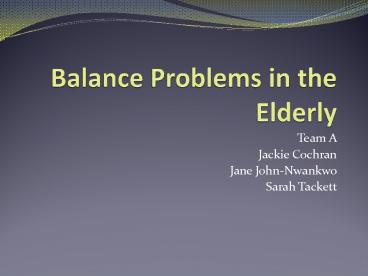Balance Problems in the Elderly - PowerPoint PPT Presentation
1 / 13
Title:
Balance Problems in the Elderly
Description:
Demographics and the economy. ... Those with high EFST scores were more likely to report four or more sick days in the past six ... and symptoms of depression. – PowerPoint PPT presentation
Number of Views:96
Avg rating:3.0/5.0
Title: Balance Problems in the Elderly
1
Balance Problems in the Elderly
- Team A
- Jackie Cochran
- Jane John-Nwankwo
- Sarah Tackett
2
Introduction of Aggregate
- Elderly age 60 and older
- 12 United States Population is over 65 years of
age - Reside in Assisted Living Facility
- Risk for balance problems
3
Epidemiology TriadElderly with Balance Problems
- Host
- Elderly 60 years and older
- Male and Female
- Agent
- Physical
- Aging affects strength and balance
- Chemical
- Side effects of medications
- Exposed to Communicable Disease
- Community Acquired Pneumonia cause weakness,
poor nutrition - Environment
- Poor lighting, throw rugs
- Clutter
- Small Rooms at Assisted Living Facility
4
Balance Needs Assessment
- Diming of senses
- Five senses decrease
- Musculo-Skeletal
- Muscle and bone atrophy
- Medications
- Sensory and cognitive deficits
5
Validation of fall risk assessment for seniors
- Disability and rehabilitation
- Fall risks increase after age 60
- The risks increase as the age increase
- Risks were associated with other medical problems
associated with aging - Balance test used
- The Tinetti Performance-Oriented Mobility
Assessment (POMA) - The Timed "Up Go" Test (TUGT)
- Berg Balance scale
6
Gaps in Data
- Data explored showed no change in information.
7
(No Transcript)
8
World Health Organization Agenda
- Six point Agenda to improve public health
- Promote Development
- Foster Health Security
- Strengthen Health Systems
- Harness Research, Information Evidence
- Enhance Partnerships
- Improve performance
9
WHO Agenda Population Ageing
- Term for Elderly 60 and up
- Increase in population internationally
- Encourage Physical Activity
- Improve functional status
- Improve quality of life
- Improve Mental Health
- Reduces risk of Falls
- Balance exercises are key for those who are risk
for falls - WHO Falls Prevention for Active Ageing Model
10
WHO Falls Prevention for Active Ageing Model
- WHO Falls Prevention for Active Ageing Model
- Action plan to Reduce Occurrence of Falls
- Build Awareness
- Improve Assessments
- Implement Culturally Appropriate interventions
11
ConclusionEvery 18 seconds an older adult is
treated in an emergency department for a fall,
and every 35 minutes someone in this population
dies as a result of their injuries.
12
References
- American Family Physician (2000). What causes
falls in elderly. Retrieved Sept 18, 2009 from
http//www.aafp.org/afp/20000401/2173ph.html - Center for Disease Control (2009). Falls among
older adults an overview. Retrieved on
September 6, 2009 from http//www.cdc.gov/Homean
dRecreationalSafety/falls/adultfalls.html - Clark, M. (2008). Community health nursing
Advocacy for population health (5th ed.). Upper
Saddle River, NJ Prentice Hall. - Cwikel, et al (1998)Disability and
rehabilitation. Validation of a fall risk
screening test (EFST), for community dwelling
elderly retrieved from http//www.ncbi.nlm.nih.gov
/pubmed/962226 - Dicker, R. (2002). A brief review of the basic
principles of epidemiology. In M.B. Gregg (Ed.)
Field epidemiology (2nd ed) pp 8-25. New York
Oxford university.
13
References (cont)
- Lyons. S. S. (2004). Fall prevention for older
adults . Iowa City (IA) University of Iowa
Gerontological Nursing Interventions Research
Center, Research Dissemination Core. National
Guideline Clearinghouse. Retrieved September 20,
2009, from http//www.guideline.gov/summary/summar
y.aspx?doc_id4833nbr003480stringelderly - Kaiser Family (2007). Demographics and the
economy. Retrieved September 4, 2009,from
http//www.statehealthfacts.kff.org/comparemaptabl
e.jsp?ind2cat1sub1yr85typ2sort3oa - Use of clinical and impairment-based tests to
predict falls by community-dwelling older adults.
(Research Report) retrived from - http//www.thefreelibrary.com/Useofclin
icalandimpairment-basedteststopredictfallsb
y...-a099848607 - Raiche, et al (2000) retrived from
http//www.capsil.org/capsilwiki/index.php/Perform
ance_Oriented_Balance_and_Mobility_Assessment_(POM
A) - Vergados, D. (2008). Service personalization for
assisted living of elderly people at home. CS
Digital Library. Retrieved September 4, 2009,
from http//www2.computer.org/portal/web/csdl/doi/
10.1109/SMAP.2008.38 - World Health Organization (2009). Definition of
an older elderly person. Retrieved September 4,
2009, from http//www.who.int/healthinfo/survey/ag
eingdefnolder/en/index.html































